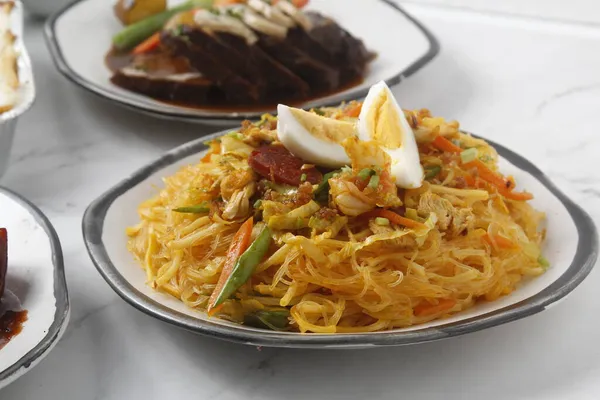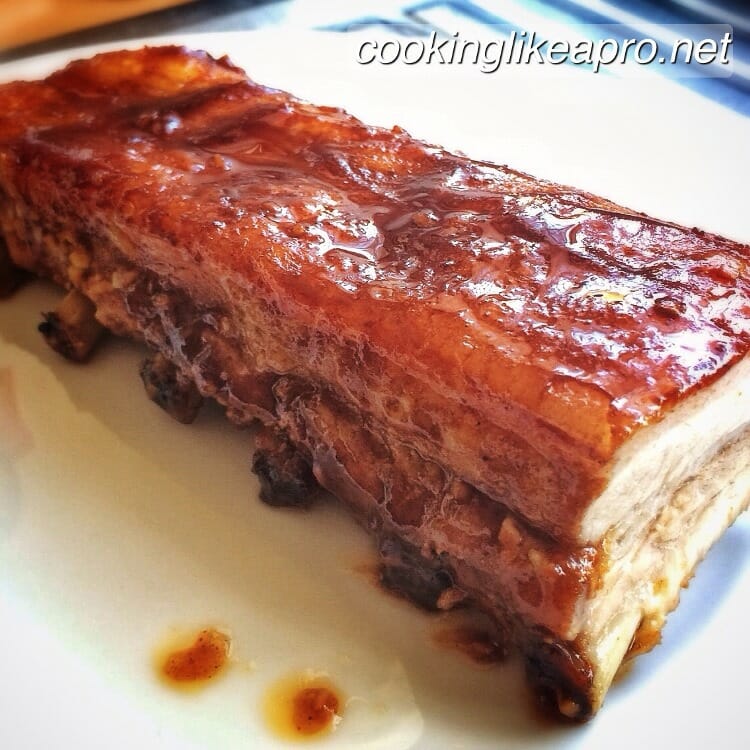Pancit sotanghon or pancit bihon… which pancit variant do you prefer?

They seem to be alike; but they are not. The first one’s made of cellophane noodles, glossier than the latter; as the second one is made of rice noodles. I, for one, like to cook with sotanghon noodles over the other. It’s just less soggy to work with. It doesn’t break easily as compared to the bihon. As to its taste however, I like whichever’s presented on the table.
This pancit sotanghon recipe is just like any other… with the addition of one particular ingredient – the kale. The vibrant green of this vegetable brings nice colors and texture to the mix. Also, it’s one superfood so it definitely increases the nutritional value of the pancit.
Here’s how CookingLikeAPro do pancit sotanghon at home.

Pancit Sotanghon
Ingredients
- 250 g Vermicelli noodles sotanghon
- 400 g Chicken breast cut in thin shreds
- 200 g Pork or chicken liver cut in small pieces
- 5-7 cloves Garlic crushed and chopped
- 1 whole Onions chopped
- 1 whole Carrots cut in strips
- 300 g Green beans cut into strips
- Green and/or red bell pepper at least half, cut into strips
- 2-3 leaves Kale chopped
- ¼ whole Cabbage cut into shreds
- 2 tbsp Fish sauce
- 6 tbsp Soy sauce
- 2 cups Water
- 2 tbsp Cooking oil
- Salt and pepper to taste
Instructions
- Soak the vermicelli noodles in tepid water. Set aside for later.
- Put oil in a heated pan or wok.
- Put in the garlic. Saute until golden brown.
- Put in the chicken. Fry for 10-15 minutes under medium heat.
- Season with fish sauce.
- When the chicken turns a bit charred, add in the onions.
- When the onions sweat, add in the chicken liver. Stir for under a minute.
- Put 1 cup of water. Allow to boil.
- Add in all the vegetables.
- Season with 3 tbsp of soy sauce.
- Stir well until the veggies are cooked. Take care not to overcook them.
- When they appear to be in a more vibrant color, scoop them out and let them rest.
- Put the noodles in the pan.
- Add the rest of the water and soy sauce.
- Stir well until the noodles are cooked.
- Season the dish with salt and pepper.
- When the noodles are ready, put the vegetables on top.
- Serve while hot.
Video
Notes
Tips and Tricks to make Pancit Sotanghon

A Filipino favorite is the guisado version of Pancit Sotanghon. It’s easy to prepare and serves a large crowd. It can also be served with scrambled eggs or as an appetizer. The recipe for Pancit Sotanghon is very versatile. It’s not hard to make and you can easily cook multiple batches at a time. Try grouping ingredients and cooking them in one bowl. This will save you from mixing and dicing them.
Serving Suggestions
There are so many tasty ways to serve your Pancit Sotanghon:
- Top with fried garlic, chopped green onions, and chili oil for some crunch and heat.
- Add a squeeze of calamansi or lemon juice to brighten up the flavors.
- Scoop it into small pans de sal buns for a delicious noodle sandwich.
- For some protein, cook up some shrimp, chicken, or pork to mix in.
- Garnish with fresh herbs like cilantro, basil, or chives.
- For texture, add some crushed chicharron, peanuts, or cashews.
- Serve with a side of fresh vegetables like cucumbers, lettuce, and tomatoes for some crunch.
- For a one-bowl meal, add a fried egg on top.
Storing and Reheating Leftovers

Like many noodle dishes, Pancit Sotanghon tastes even better the next day! Here are some tips:
- Let it cool completely before storing to avoid condensation.
- Transfer to an airtight container and refrigerate for up to 3 days.
- To reheat, add a few tablespoons of water to the container to loosen it up.
- Microwave in 30 second intervals until heated through, stirring between each.
- You can also reheat gently in a skillet over medium-low heat with a bit of oil.
- Add more seasonings like soy sauce or oyster sauce if needed.
FAQs

Here are some common questions about making this classic Filipino noodle dish at home:
What noodles do you use in Pancit Sotanghon?
You use glass noodles, also called cellophane noodles, bean thread noodles, or sotanghon. They are translucent and made from mung bean starch.
Can I use rice noodles instead?
Rice noodles like bihon or rice sticks work too but the texture will be much softer and more delicate than the traditional chewy glass noodles.
What protein can I add?
Popular proteins are chicken, pork, shrimp, Chinese sausage, fish balls, beef, and liver. Use whatever you have on hand!
How do I cut the vegetables?
Cut them into thin, uniform strips about 2-3 inches long so they cook quickly and evenly. Keep them tender-crisp.
What is the sauce made of?
The sauce includes soy sauce, oyster sauce, chicken broth, and sometimes a little sugar. The noodles soak up the sauce as it cooks.
Should I soak the noodles first?
Nope, no need to pre-soak. Just add them straight to the pan. They’ll soften up as they cook.
Can I use a skillet instead of a wok?
Yes, a Best Nonstick Skillet For Eggs works fine, just make sure it has sloped sides to help toss the noodles easily.
Enjoy This Tasty Noodle Dish!
Pancit Sotanghon is truly one of the tastiest noodle dishes in Filipino cuisine. With its signature chewy glass noodles and assortment of vegetables and protein sautéed in a savory sauce, it’s no wonder this stir fry is so beloved. I hope you’ll give this classic recipe a try soon – it’s guaranteed to be a hit! Let me know if you have any other questions. Enjoy!






